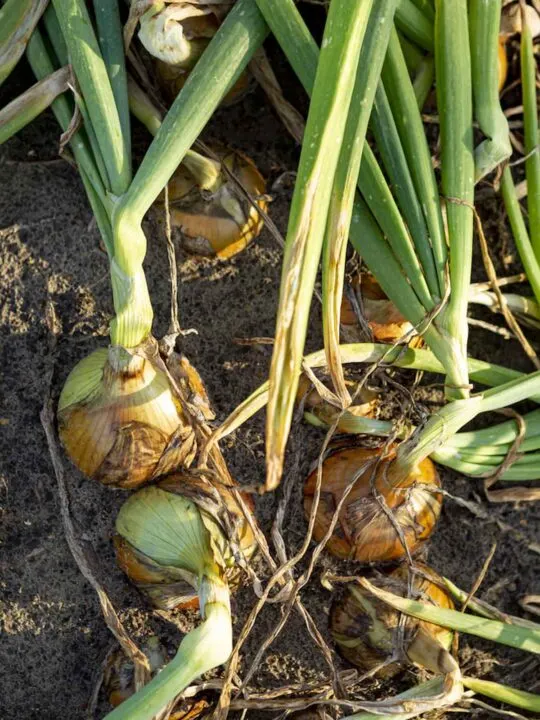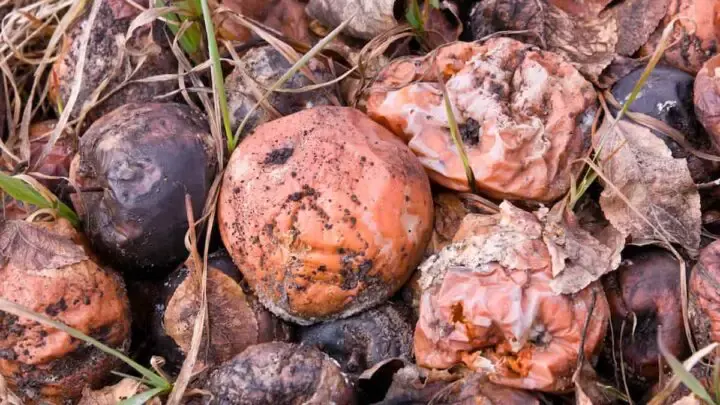There is possibly nothing worse than harvesting your onions to find that they are hollow on the inside. This is especially true if your onion bulbs are also showing signs of rotting. So, what causes onions to be hollow anyway?
Most of the time, hollow bulbs on onions are caused by damage from pests, bacterial infections, or fungal infections. Additionally, onion bulbs can occasionally become hollow due to growing and development problems.
Here we will be explaining all of the reasons why onion bulbs are sometimes hollow and if there is anything that you can do to prevent these issues. We will also be explaining whether or not overwatering can cause onions to be hollow and if it is safe to eat a hollow onion. Let’s get into it!

What Causes Hollow Onions?
A wide variety of pests can cause onions to be hollow. This is because these pests eat onion bulbs, which can lead to them being hollow if left to eat them for long enough.
In addition, some bacterial and fungal infections can cause onions to rot from the inside out, leading to a hollow center. Here are all of the possible causes for hollow onions.
Botrytis Rot Can Hollow Out Onions
Botrytis rot is a fungal infection that can affect an onion’s stems, leaves, and bulbs. When the fungus infects an onion bulb, it goes in through the plant’s neck and infects the center of the bulb.
If the condition is left for long enough, Botrytis rot can completely rot out the center of the bulb, leaving it brown, slimy, and hollow. You may also notice water damage and spots on the outside of the bulb.
Cold and wet conditions can lead to a Botrytis rot infection in onions. This includes when the onion is both in storage and in the ground. Planting your onions in well-draining soil and storing onions in a dry environment can help to prevent Botrytis rot.
Fusarium Basal Plate Rot Can Also Make Onion Bulbs Mushy And Hollow
This condition is caused by a fungal disease found in the soil, particularly in warm and moist soils. Planting your onions in well-draining soil and rotating crops can help to prevent your onions from being affected by this condition.
When an onion is infected with this fungal disease, then they tend to have bulbs that are mushy in texture and brown in color. This can sometimes leave the bulbs with a mushy, brown, hollow center. You will also likely notice that the leaves of infected onion plants are shriveled and yellow.

Center Rot Literally Rots Out The Onion Bulb Center
Center rot is a bacterial infection native to North America, and it is most prevalent in warm and humid environments. This disease affects the center of onion bulbs, causing them first to go brown and then to rot from the inside out.
This will often lead to an onion bulb interior that is brown and hollow, and most onions with center rot will also have a foul smell. This disease is spread through thrips, so it is recommended that you get these pests removed quickly when you notice them.
Slippery Skin Makes The Inside Of An Onion Hollow And Shrivelled
Slippery skin is a bacterial infection that will affect the neck and interior of onion bulbs. This condition mainly works in the bulb’s interior, leaving it hollow, shriveled, and dried out. Unfortunately, there are not any noticeable exterior signs of Slippery skin infection in onions. This bacterial infection usually gets to the onions through the damage done to the exterior before harvest.
Soft Rot Makes The Inside Of The Onion Bulb Soft And Mushy
Soft rot can be caused by various types of bacteria spread through water and pests, especially insects that eat onions, such as onion maggots. As a result, keeping an eye out for pests and planting your onions in well-draining soil can help prevent soft rot.
When onions are infected with soft rot, the interior of the bulb will be completely rotted. The hollow middle of the bulb is usually filled with liquid and mushy dead plant material. It is also common for onions with soft rot to have a very bad smell.

Pests That Eat Onion Bulbs Could Also Cause Them To Have Hollow Bulbs
Insects that commonly eat onion bulbs could eat them from the inside out when they have a point of entry. This is especially true if the infestation is very severe. Some pests that commonly eat onion bulbs include:
- Bulb Mites
- Stubby Root Nematodes
- Onion Maggots
- Wheat Curl Mites
- Thrips
Not only do these pests physically eat the onion bulbs themselves, but the damage done to the onion plants as a result of these infestations can cause the plant to rot and die. Additionally, many of these pests will also carry bacterial infections that can also lead to rot in the onion bulb’s center.
Black Mold Can Hollow Out Onions During Storage
Black mold, though usually just on the outside of onions, can also infect the inside of the bulb. This can easily lead to the interior of the bulb rotting away, leaving a hollow center. Most of the time, black mold infests onions when they are stored in moist conditions.
Growing Problems Can Cause Onion Bulbs To Be Hollow In The Center
On rare occasions, onions could become hollow in the center when they mature too quickly, leading to bolting, which in a fully grown onion is completely fine.
However, in onions that are too young, this could lead to an onion bulb with only a few thick rings and a hollow center. Onions affected by this problem should not be mushy, discolored, or smelly on the inside.
Can Overwatering Cause Onion Bulbs To Rot And Hollow On The Inside?
Although overwatering can easily cause onions to rot, this rot usually starts on the outside of the bulb and slowly go towards the center. This means that onions that are rotten due to overwatering are rarely hollow in the middle. It is more likely that a rotten and hollow center in onion bulbs was caused by an infection or pest infestation rather than overwatering.
Is It Safe To Eat Hollow Onions?
No, it is usually not safe to eat a hollow onion because hollow onions are usually the result of rotting, and it is not the best idea to eat a rotted plant. Not to mention, many hollow onions are also infested with pests, and they will have a bad taste and texture to them as well.

Hi there, my name is Allie and welcome to my blog; GareningWithAllie!
Much of what you see written here is just our personal experiences with gardening. Along with the content I write here, there is also a unique collection of gardening topics covered by some of our close friends. I hope you find everything you read here to be helpful, informative, and something that can make your gardening journey the most lovely experience ever! With that said, Happy Gardening!
